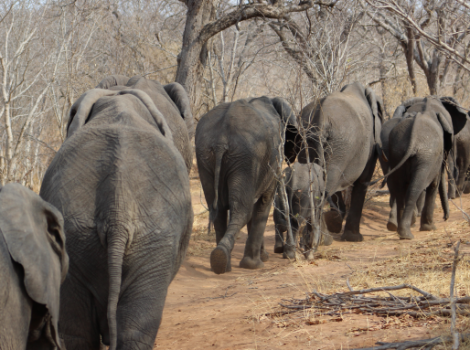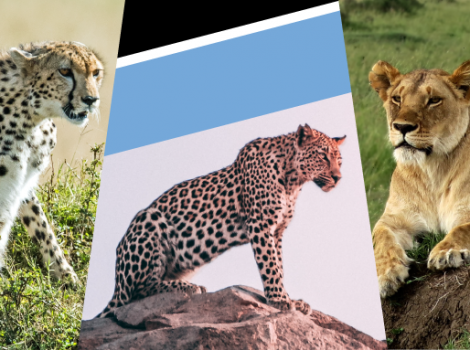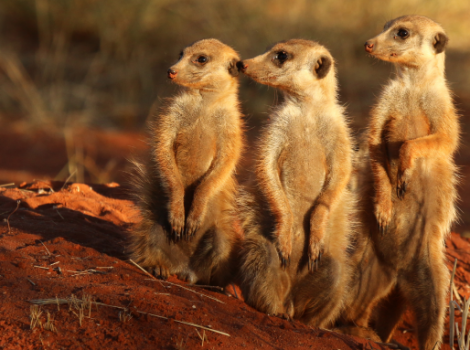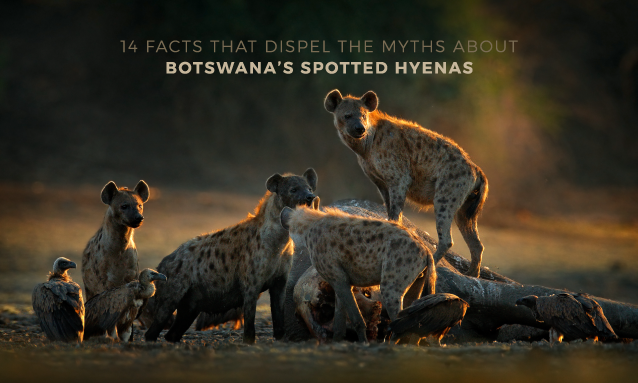
The spotted hyena (Crocuta crocuta) is the most widespread predator in Africa and is found in just about every country south of the Sahara Desert. They occur in diverse habitats from the dry Kalahari regions to the wetlands of the Okavango Delta. Their maniacal laughs, unearthly shrieks and haunting whoops add to the mystery of the night on a Botswana safari.
Hyenas often have a bad reputation and are often viewed with revulsion. This may have something to do with African folklore. They are a widespread symbol in African myth and can represent anything from understanding to being a symbol of immorality. In reality, they are extremely intelligent animals that often kill prey for themselves.
Why are spotted hyena always the bad guys? Their heavy build, great hulking shoulders, their loping gait, and their large, blunt-nosed faces do not contribute to an overall cuddly look. Plus, there is that whole hermaphrodite rumour. But many of the nightmarish stories associated with hyena are, in fact, myths.
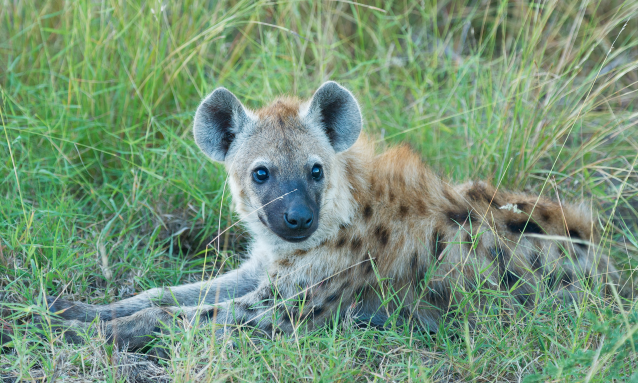
Long misunderstood as dim-witted, gluttonous scavengers with a demonic laugh, the hyena has a “serious PR crisis on its paws,” says Arjun Dheer, a Ph.D. student at the Leibniz Institute for Zoo and Wildlife Research in Germany, who studies spotted hyenas in Tanzania’s Ngorongoro Crater.
“The visceral reaction any time I tell someone I’m working with hyenas is, Ew gross, why?”
That’s because centuries of literature and traditional folklore—often featuring stories of witchcraft, grave-digging, and sexual deviance—have cemented a “deep-rooted disgust for the hyena in the human psyche,” he says.
Aristotle described the hyena as “exceedingly fond of putrefied flesh.” Hemingway labelled the animal a “hermaphroditic, self-eating devourer of the dead.” And Roosevelt called it a “singular mixture of abject cowardice and the utmost ferocity,” according to a 1995 study on the hyena’s status throughout history. Pliny the Elder, an ancient Roman author, wrote that hyenas can magically freeze other animals in place.
With such an unsavoury history, it’s no surprise pop culture depictions of hyenas have followed suit. The Disney movie, The Lion King again portrays a trio of spotted hyenas as evil sidekicks of the villain Scar. (The Walt Disney Company is majority owner of National Geographic Partners.)
Although spotted hyenas of East and southern Africa are the most commonly maligned, the four species are often lumped together as one. The brown hyena, the rarest species, is native to southern Africa; aardwolves are monogamous insect-eaters found in East and southern Africa; and striped hyenas, the smallest and least-studied species, live in fragmented populations across Asia and northern Africa.
Mostly, it’s fear and lack of understanding of these hyenas, coupled with their unusual appearance and scavenging tendencies, that have spawned so many negative stereotypes, says Dheer. But, he says, it’s time to set the record straight. And we at YourBotswana couldn’t agree more.
Fast facts
- Weight:About 35 to 80 kilograms (77 to 176 pounds)
- Size:95 to 150 cm in length (37 to 60 inches); 75 to 85 cm at the shoulder (30 to 33 inches)
- Life span:Up to 20 years in the wild and 25 years in captivity
- Gestation:90 to 110 days
Physical characteristics: The hyena is Africa’s most common large carnivore. There are three hyena species – spotted, brown, and striped. Spotted hyenas are the largest of the three. They are fairly large in build and have relatively short torsos with lower hindquarters and sloping backs. They have excellent night-time vision and hearing.
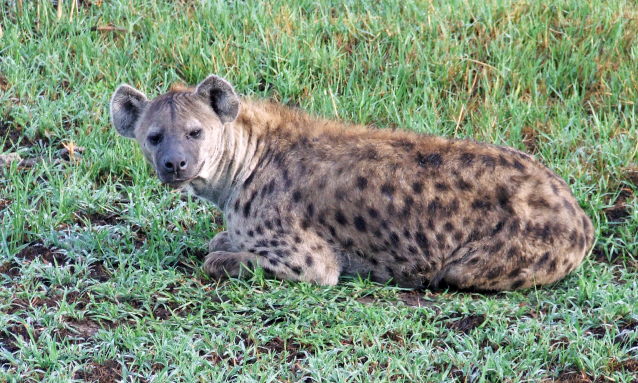
Behaviour & Diet:Hyenas are not picky eaters. They consume animals of various types and sizes, carrion, bones, vegetable matter, and other animal droppings. Their jaws are among the strongest in relation to the size of any other mammal. Their jaws and digestive tract allow them to process and obtain nutrients from skin and bones. The only parts of prey not fully digested are hair, horns, and hooves — these are regurgitated in the form of pellets. The high mineral content of the bones makes their droppings a highly visible, chalky white. According to campers, these animals have even been known to consume aluminium pots and pans.
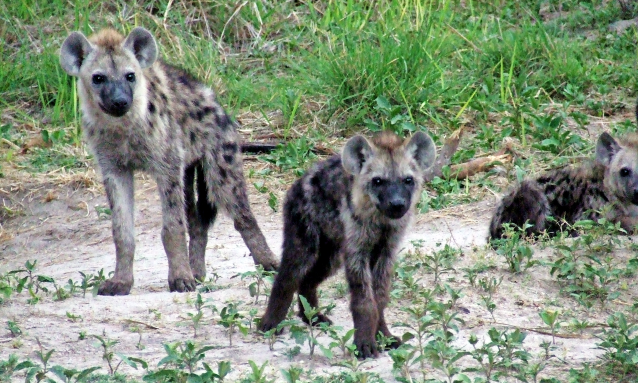
Hyena cubs:They usually bear litters of two to four cubs. Cubs begin to eat meat from kills near the den at about five months, but they are suckled for as long as 12 to 18 months — an unusually long time for carnivores. This is probably a necessity, as most kills are made far from the den, and hyenas, unlike jackals and hunting dogs, do not bring back food and regurgitate it for their young. At about one year, cubs begin to follow their mothers on their hunting and scavenging forays. Until then, they are left behind at the den with a babysitting adult.
Dispelling the myths
1. Fact! Hyenas are very social animals that are usually led by a dominant female and all males and the other females are subservient to the female members of the clan and there is a complex social hierarchy.
The best areas in the Delta to see Hyena are the Savuti and Linyanti regions where there are thriving populations. It is not known how many hyenas call the Delta home, but it is thought that there are several hundred.
These are social creatures and they live in clans of up to 80 animals. The stable core of a clan consists of a dominant female and successive generations of her daughters and their offspring. Clans also contain resident males and immigrant males. The immigrants will only be accepted to membership after weeks of cautious approaches and subordination during which they bear the brunt of the clan aggression. Female cubs inherit their mother’s rank and will fight furiously for this rank. It is common behaviour in a pair of twins for one to kill her sister.
They form tight-knit family groups, forge impenetrable bonds with one another and are extraordinarily tough. Spotted hyena live in clans of varying size, and each clan is ruled over by a dominant matriarch – the clan females (including any young cubs) are superior to the smaller, more submissive males.
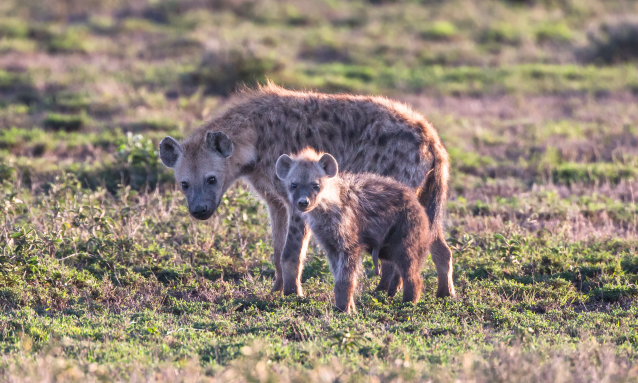
They recognise each other by sight and stand head to tail alongside each other while carefully inspecting the erect genitals of the partner. They display a complex greeting ceremony, which clan members use to reinforce social bonds.
Spotted and brown hyenas live in tight-knit clans that are led by an alpha – often a female – and include lower-ranking females, males, and young. Clan size depends mostly on prey availability, ranging from 10 members to around 80 animals.
Such large and complicated groups make spotted hyenas “the most socially complex carnivores in the world,” Dheer adds.
“You couldn’t maintain all these social bonds if you weren’t intelligent,” adds Ingrid Wiesel, founder of the Brown Hyena Research Project, who studies brown hyenas in coastal Namibia.
2. Myth: Hyenas are scavengers
As the storyline goes, “the lion is the king, and the hyena is a skulking, nasty, dirty thing because it’s a scavenger,” says Christine Drea, an evolutionary anthropologist at Duke University who has studied spotted hyenas.
This myth refuses to die, she says, “even with the evidence to the contrary staring everyone in the face.”
The truth? Hyenas are excellent hunters whose spoils are more likely to be stolen by lions than the other way around. In the Serengeti in the 1970s, zoologist Hans Kruuk found that when spotted hyenas and lion share a carcass, hyenas were responsible for the kill 53% of the time.
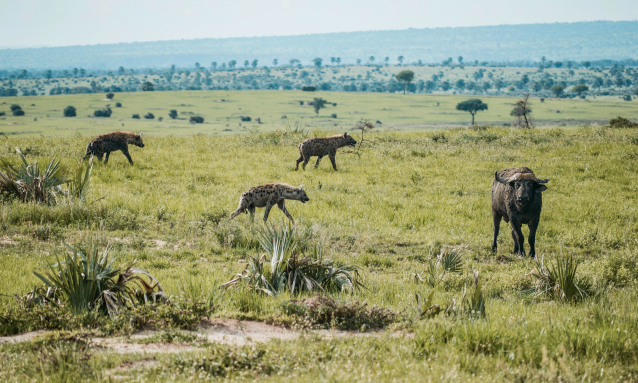
Spotted hyenas can take down buffalo and baby elephants, hunting alone or in groups — a “flexibility that gives them an advantage over their competitors,” Dheer says.
That’s not to say that hyenas will ignore available food. Drea notes; “Any self-respecting carnivore would scavenge if given the opportunity.”
They are powerful hunters in their own right. They do eat carrion from leftover kills, like most predators, but this habit is essential for the support and maintenance of the ecosystem in which they exist.
3. Fact! Hyenas are one of the most common and successful predators that you will see while on safari in the Savuti region of Botswana.They are accomplished hunters and they get up to 75% of their food from their own kills. In Botswana’s Kalahari Game Reserve and Chobe National Park, they kill 70-80% of their own prey.
Hyenas are less skilled at stalking than cats and instead, rely on their speed and stamina to run down their prey. They can sprint at 60 km/h and keep up a speed of 40 to 50 km/h over 5 km. They kill their prey by biting chunks out of it and targeting major blood vessels as it runs.
4. Fact! Dietary habits – opportunistic feeders
Hyena clans generally feed on low-density resident game such as Impala and Warthogs, but will also feed on the newborns of the migrating herds – especially during the annual Zebra migration.
The Hyenas digestive system is legendary, and they have extremely strong jaws that easily allow them to crush bones. Sledgehammer-like jaws shatter bones, while highly acidic stomachs break down the shards. They eat vegetation as well as bones and have been known to eat camper’s supplies, as well as the tin!
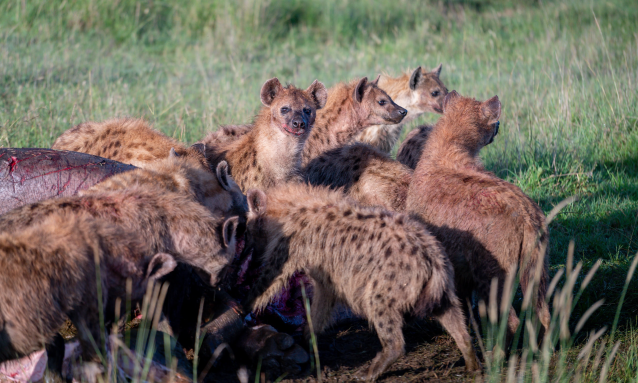
They are opportunistic feeders and are known for their powerful jaws and cast-iron digestive system, eating their way through canned food and pots raided from campsites. They scavenge just about anything and regularly finish off the kills of other predators. They have been known to eat fruit and the faeces of other animals.
- In the Savuti, 80% of hyena kills are Burchell zebra.
- They usually go for large and medium-sized antelope and select young or weakened targets.
- They have been known to tackle anything from mice to baby elephants.
- They are said to be the predators most likely to attack humans sleeping outside in the open.
- The staple diet consists of blue wildebeest, gemsbok, zebra and impala.
- Food is sometimes stored in caches, in shallow water where jackals and vultures are unable to get at them.
If harassed at a kill by superior numbers of other predators they may cut their losses by tearing a piece off the carcass and running away with it. Where clans are large and there is competition from other predators, they gorge themselves as fast as possible. They are very noisy when they feed and often chase each other around at meals. They do not, however, fight over food like lions do.
5. Fact! The hyena and lion are sworn enemies
Hyenas and Lion compete over food resources and this often leads to a bitter conflict between these two species. The rivalry between the Savuti lions and hyenas was documented in the 1960s by world-renowned wildlife documentary makersDereck and Beverly Joubert.
The film shows how the lions and hyenas literally go to war over the scarce food resources in the area. Hyenas instinctively fear lions but will take them on, and lions have been known to kill Hyena cubs. Lions generally ignore hyenas except when trying to take their kill of them. Sometimes, however, they may feed alongside each other and if they have enough numbers, they may even force Lions off a kill.

Usually, lions cannot be displaced from a carcass by a hyena if an adult male is present. However, if they are heavily outnumbered, even lions give away their food to them.
6. Breeding
Spotted Hyenas can breed at any time of the year although most give birth during the wet season when their prey is giving birth and there is lots of easy prey available. They usually give birth to two cubs at a time.
The dominant female usually gives birth to the female that will become her successor as this is determined by size and aggressive behaviour. They are born with eyes wide open and teeth well developed.
During pregnancy, the mother produces extra androgen which will cause the cub to be large in size and aggressive in nature. The matriarch’s cubs will automatically outrank the other cubs and members of the clan.
7. Fact! Hyenas are territorial
Hyenas mark their area by anal gland pasting, especially near the borders of their territory. They also mark areas by defecating in large middens and by pawing the ground to deposit smelly secretions from glands on their feet.
- Most pasting near the den is done by males and young, low-ranking females.
- Groups will patrol territory boundaries and scent-mark systematically.
- Encounters between different clans may result in violent battles.
- The battles usually involve all members of the two clans, in which the losers are savaged and killed.
8. Fact! The hyena dominance hierarchy
Unusually among mammals, females are larger than males and dominate them. Cubs dominate males and once they have been admitted to the clan, immigrant males also outrank resident males. Dominant animals are usually bigger than subordinates. Cubs inherit the rank of the mother. Only the highest-ranking immigrant male actually mates.
The privileges of being high-ranking females are priority access to food and to resting sites near the den entrance.
- They also rear more cubs than low rankers.
- The aggressive animal curls its tail over its back, pricks its ears forward and, keeps its mouth closed.
- A submissive hyena holds its ears low, opens its mouth and tucks its tail between its legs.
- “Grinning” and laying the ears back displays a submissive greeting.
9. Myth! Hyenas are stupid
The Lion King’s hyena trio, Shenzi, Banzai, and Ed, lurk in the shadows of the elephant graveyard. Ed is dim-witted, with unfocused eyes and a floppy tongue and he gnaws on his own flesh. Under Scar’s leadership, the hyenas contribute to the collapse of the entire Pride Rock ecosystem.
In reality, these apex predators are critical to controlling prey populations and preventing the spread of disease, particularly by eating every last bit of an animal, Dheer says.
The spotted is probably the most maligned for its so-called brutish appearance, and yet it has been discovered to have the largest brain compared with the striped and brown hyena. Scientist Kay Holecamp of Michigan State University ran a selection of hyena skulls through a CT scanner and was able to discern that the front section of the spotted hyena brain (used for advanced decision making) is particularly large.
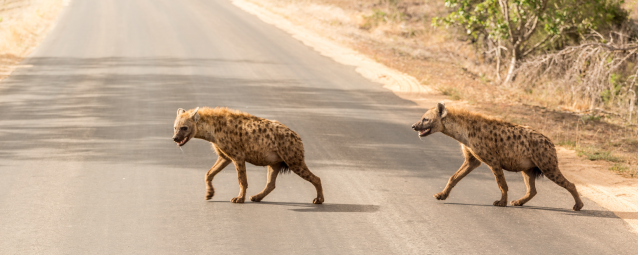
10. Myth! Hyenas laugh.
Far from being the hallmark of evil plotting and tyranny, as Walt Disney would have you believe, vocalisations keep hyena societies intact. Their classic whoop serves to recruit more hyenas during a fight with lions, advertise a male’s fitness, or simply communicate with other hyenas about location. Then there’s the oft-misunderstood laugh or giggle, which is unique to the spotted hyena.
For centuries, authors have described this sound as deceitful or mischievous. “I will laugh like a hyena, and that when thou art inclined to sleep,” Shakespeare writes in As You Like It.
In truth, it’s not a happy noise. A lower-ranking animal makes this laughing-like sound when it’s upset or stressed, Dheer says.
Hyenas make a variety of vocalisations, including wailing calls, howling screams, and the well-known “laughter,” which can be heard up to 5km (three miles) and is used to alert other clan members of a food source and their location.
- They have quite a rich repertoire of vocal signals.
- Cubs whine when they beg for food or milk.
- When chased off a kill they “giggle”.
- If surprised or frightened they will give a series of short, quiet grunts.
- Grunts and growls signal an imminent attack.
- Fast whoops are used to attract members to carcasses and to recruit them for confrontations against lions.
11. Myth! Hyenas are weak.
In the meagre deserts of southern Namibia, brown hyenas maintain home ranges of up to 1,150 square miles. An animal will walk an average of 15 miles a night in search of a meal, often baby seals.
Such endurance is due in part to their streamlined body shape. Stubby hind legs increase energy efficiency, allowing the animals to lope easily across the ground. Hyena also have big, strong lungs and hearts as well as wide nostrils that facilitate oxygen exchange.
12. Myth! Hyenas stink.
The Kaguru people of Tanzania believe hyenas dig up the graves of the dead, which, according to their beliefs, is why they smell bad. In reality, hyenas actually don’t have much of a smell, say Dheer and Wiesel.
“You want to talk about a stinky animal,” Dheer says with a laugh, “the African wild dog rolls in its own poop.”
Hyenas do produce a substance from their anal gland that scientists have nicknamed “hyena butter” – it’s a paste used to mark their territories and smells like mulch, Dheer says.
13. Myth! Hyenas are hermaphrodites.
Spotted hyena females are often mistaken for males. They have genitals that resemble males’. When two hyenas—male or female—greet, the higher-ranking animal will sniff the lower-ranking animal’s genitals to reinforce bonds and lower stress levels. Females also urinate, mate and give birth through this pseudopenis.
It’s this physical trait that has particularly harmed the hyena’s public persona. In Physiologus, a Christian text from the second century A.D., the hyena is said to alternate between male and female and thus “is unclean because it has two natures,” according to the 1995 study.
The female spotted hyena has a pseudo-scrotum, which can make it rather difficult to sex her at first glance. This is unusual, but not “creepy,” as some articles like to make out.
The truth!
- Hermaphrodites are animals that are both male and female.
- The females have assumed some male attributes, which lead to some confusion in differentiating the sexes.
- The most puzzling feature is that females as well males, seem to have male genitals.
- A female spotted hyena has an erectile pseudo penis and false scrotum filled with fat, which is as large as a male penis.
- Females average about 10 kg more in weight than their male counterparts.
They have high levels of male hormones known as androgens, which might explain their dominating aggressiveness and large size.
14. Truth! Hyenas are vulnerable to extinction.
Because of habitat loss and widespread hunting, striped and brown hyenas are classified as near-threatened by the International Union for Conservation of Nature, the body that sets the conservation status of species.
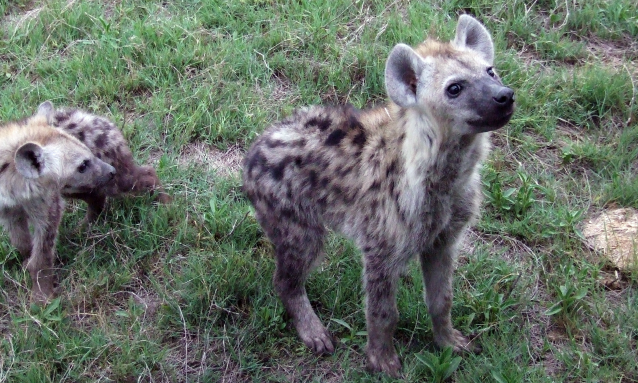
And though the aardwolf and spotted hyena are listed of least concern, “I am concerned,” Dheer says.
Spotted hyenas are locally extinct throughout much of South Africa, as well as West and Central Africa. Persecuted by farmers and poachers, their numbers seem to be declining outside of protected areas, according to Dheer.
“I’m not super optimistic about their future, especially considering their negative public perception,” he says.
That’s why he and his colleagues are working hard to boost hyenas’ profile, especially on social media.
“If non-scientists could speak for these animals,” says Wiesel, “that would do a lot more for the public to understand they’re not so bad.”
If you want to read about Botswana’s Makgadikgadi hyenas click here.
Sources: nationalgeographic.com / The Botswana Government Facebook page / africa-wildlife-detective.com / awf.org/wildlife-conservation / itravelto.com

